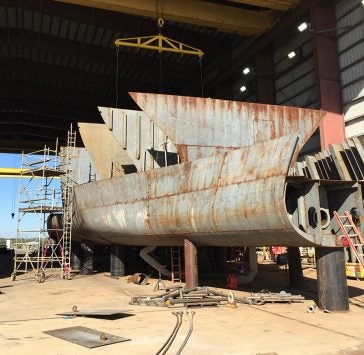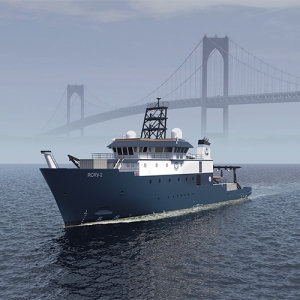Construction continues on the Regional Class Research Vessel (RCRV-2). The ship is one of three NSF-funded vessels designed with advanced capabilities for interdisciplinary oceanographic operations in areas from coastal bays and estuaries to the deep ocean beyond continental margins.
 Significant recent progress includes the melding of the RCRV-2’s first two “modules.” The RCRV hulls under construction are comprised of modules, like a series of blocks. Each hull is assembled by connecting these modules in a particular order or “build sequence.” This summer, Bollinger Houma Shipyards flipped the first two hull modules by crane, then aligned and welded them together. As these modules come together, the vessel’s side shell fitting—the “skin” of the ship—is also taking shape.
Significant recent progress includes the melding of the RCRV-2’s first two “modules.” The RCRV hulls under construction are comprised of modules, like a series of blocks. Each hull is assembled by connecting these modules in a particular order or “build sequence.” This summer, Bollinger Houma Shipyards flipped the first two hull modules by crane, then aligned and welded them together. As these modules come together, the vessel’s side shell fitting—the “skin” of the ship—is also taking shape.
The ship’s Z-Drives were delivered in July. Z-Drives are propulsion units that can rotate 360 degrees, eliminating the need for conventional rudders.
 In October, GSO announced an open competition to rename the RCRV-2, which will homeport at the Narragansett Bay Campus. As Dean Paula Bontempi wrote to the Bay Campus community, a central aspect of the vision for GSO is to become a leader in diversity, equity, inclusion and social justice. To that end, members of both GSO and the broader URI community urged that the vessel’s name, Resolution, be reconsidered.
In October, GSO announced an open competition to rename the RCRV-2, which will homeport at the Narragansett Bay Campus. As Dean Paula Bontempi wrote to the Bay Campus community, a central aspect of the vision for GSO is to become a leader in diversity, equity, inclusion and social justice. To that end, members of both GSO and the broader URI community urged that the vessel’s name, Resolution, be reconsidered.
The competition invited the public to submit names that honor individuals, communities or ideas that have furthered our understanding of the ocean, and whose recognition is long overdue.
Dean Bontempi has formed a naming committee at GSO to establish an equitable and inclusive selection process. A set of finalists will be announced in February 2021. From the finalists, a new name will be suggested by the committee to the Dean. Bontempi will make a final recommendation to URI’s President and the vessel owner, the National Science Foundation, for consideration and approval.
For continued updates on RCRV-2 news, visit the GSO website and follow our social media channels.
